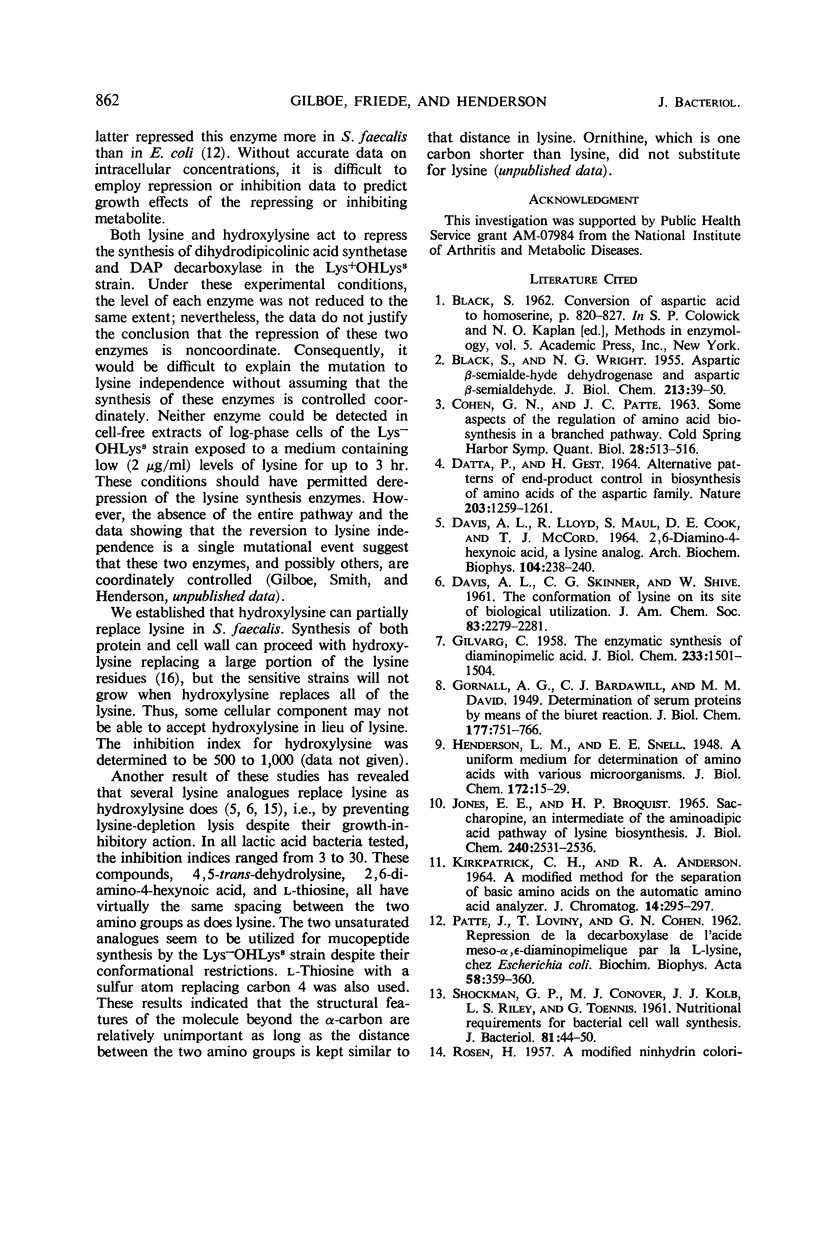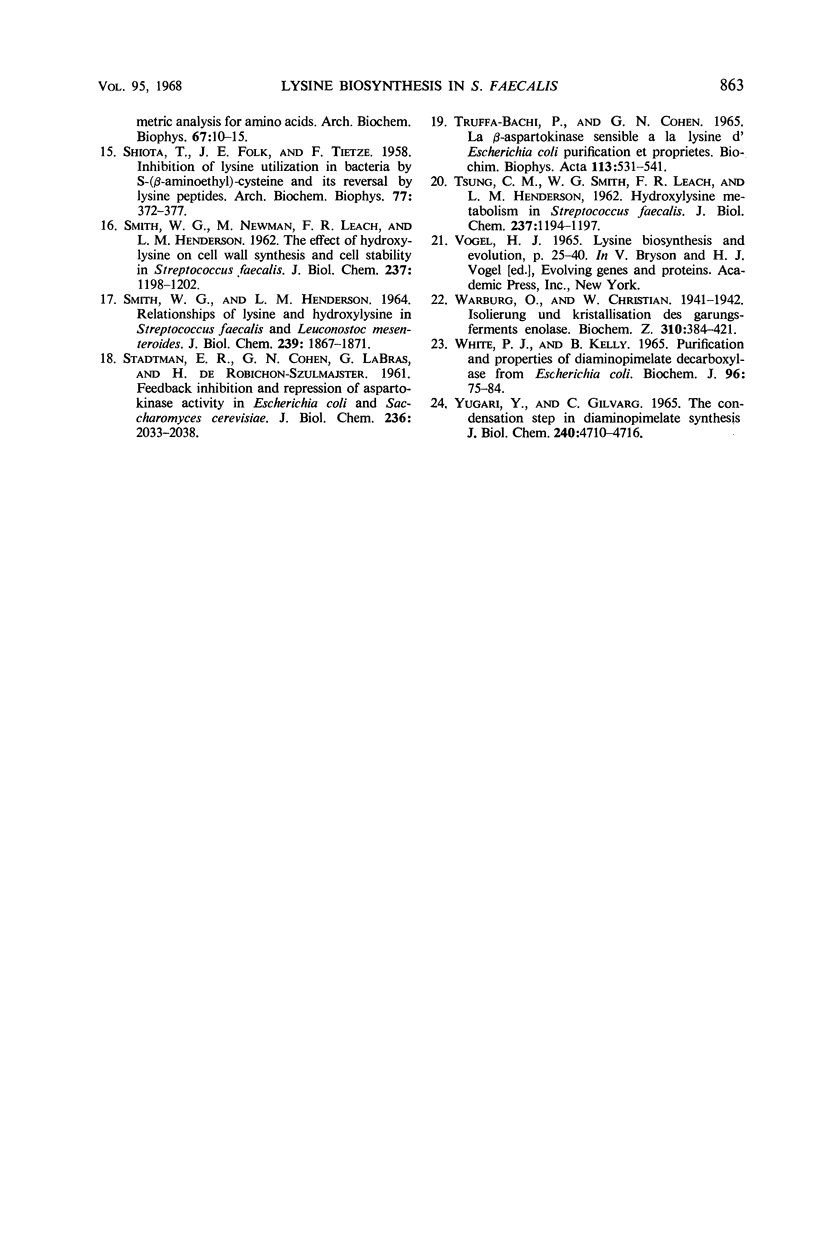Abstract
We were able to show that two lysine-independent mutants of Streptococcus faecalis ATCC 8043 contained the enzymes for the usual bacterial pathway for lysine biosynthesis. Because of this synthetic capacity, one mutant, the Lys+OHLyss strain, could not grow in the presence of hydroxylysine without a lysine supplement. Both lysine and hydroxylysine inhibited the first enzyme of the pathway, aspartokinase. Unlike the Escherichia coli enzyme, S. faecalis dihydrodipicolinic acid synthetase was not inhibited by either lysine or hydroxylysine. Both amino acids caused the repression of dihydrodipicolinic acid synthetase and diaminopimelic acid decarboxylase. Failure of Lys+OHLyss strain to grow in hydroxylysine-supplemented medium was caused by the mimicking of lysine control by hydroxylysine. Because hydroxylysine could not completely substitute for lysine and lysine could not be synthesized, the organism did not grow. We tested three lysine analogues and found that they prevented lysine-depletion lysis in the Lsy−OHLyss strain, as did hydroxylysine. Each analogue seemed to support cell wall mucopeptide synthesis, although ornithine did not. Preliminary data indicated that these analogues like hydroxylysine, have growth-inhibitory action on the Lys+OHLyss strain, but not the Lys+OHLysr strain. The nature of the specificity of the lysine-adding enzyme for cell wall mucopeptide synthesis is discussed.
Full text
PDF







Selected References
These references are in PubMed. This may not be the complete list of references from this article.
- BLACK S., WRIGHT N. G. Aspartic beta-semialdehyde dehydrogenase and aspartic beta-semialdehyde. J Biol Chem. 1955 Mar;213(1):39–50. [PubMed] [Google Scholar]
- DATTA P., GEST H. ALTERNATIVE PATTERNS OF END-PRODUCT CONTROL IN BIOSYNTHESIS OF AMINO-ACIDS OF THE ASPARTIC FAMILY. Nature. 1964 Sep 19;203:1259–1261. doi: 10.1038/2031259a0. [DOI] [PubMed] [Google Scholar]
- DAVIS A. L., LLOYD R., MAUL S., COOK D. E., MCCORD T. J. 2,6-DIAMINO-4-HEXYNOIC ACID, A LYSINE ANALOG. Arch Biochem Biophys. 1964 Feb;104:238–240. doi: 10.1016/s0003-9861(64)80009-6. [DOI] [PubMed] [Google Scholar]
- GILVARG C. The enzymatic synthesis of diaminopimelic acid. J Biol Chem. 1958 Dec;233(6):1501–1504. [PubMed] [Google Scholar]
- JONES E. E., BROQUIST H. P. SACCHAROPINE, AN INTERMEDIATE OF THE AMINOADIPIC ACID PATHWAY OF LYSINE BIOSYNTHESIS. II. STUDIES IN SACCHAROMYCES CEREVISEAE. J Biol Chem. 1965 Jun;240:2531–2536. [PubMed] [Google Scholar]
- KIRKPATRICK C. H., ANDERSON R. A. A MODIFIED METHOD FOR THE SEPARATION OF BASIC AMINO ACIDS ON THE AUTOMATIC AMINO ACID ANALYZER. J Chromatogr. 1964 Apr;14:295–297. [PubMed] [Google Scholar]
- PATTE J. C., LOVINY T., COHEN G. N. [Repression of meso-alpha, epsilon-diaminopimelic acid decarboxylase by L-lysine in Escherichia coli]. Biochim Biophys Acta. 1962 Apr 9;58:359–360. doi: 10.1016/0006-3002(62)91024-7. [DOI] [PubMed] [Google Scholar]
- SHIOTA T., FOLK J. E., TIETZE F. Inhibition of lysine utilization in bacteria by S-(beta-aminoethyl) cysteine and its reversal by lysine peptides. Arch Biochem Biophys. 1958 Oct;77(2):372–377. doi: 10.1016/0003-9861(58)90084-5. [DOI] [PubMed] [Google Scholar]
- SMITH W. G., HENDERSON L. M. RELATIONSHIPS OF LYSINE AND HYDROXYLYSINE IN STREPTOCOCCUS FAECALIS AND LEUCONOSTOC MESENTEROIDES. J Biol Chem. 1964 Jun;239:1867–1871. [PubMed] [Google Scholar]
- SMITH W. G., NEWMAN M., LEACH F. R., HENDERSON L. M. The effect of hydroxylysine on cell wall synthesis and cell stability in Streptococcus faecalis. J Biol Chem. 1962 Apr;237:1198–1202. [PubMed] [Google Scholar]
- Shockman G. D., Conover M. J., Kolb J. J., Riley L. S., Toennies G. NUTRITIONAL REQUIREMENTS FOR BACTERIAL CELL WALL SYNTHESIS. J Bacteriol. 1961 Jan;81(1):44–50. doi: 10.1128/jb.81.1.44-50.1961. [DOI] [PMC free article] [PubMed] [Google Scholar]
- TSUNG C. M., SMITH W. G., LEACH F. R., HENDERSON L. M. Hydroxylysine metabolism in Streptococcus faecalis. J Biol Chem. 1962 Apr;237:1194–1197. [PubMed] [Google Scholar]
- Truffa-Bachi P., Cohen G. N. La beta-aspartokinase sensible à la lysine d'Escherichia coli; purification et propriétés. Biochim Biophys Acta. 1966 Mar 7;113(3):531–541. [PubMed] [Google Scholar]
- WHITE P. J., KELLY B. PURIFICATION AND PROPERTIES OF DIAMINOPIMELATE DECARBOXYLASE FROM ESCHERICHIA COLI. Biochem J. 1965 Jul;96:75–84. doi: 10.1042/bj0960075. [DOI] [PMC free article] [PubMed] [Google Scholar]
- Yugari Y., Gilvarg C. The condensation step in diaminopimelate synthesis. J Biol Chem. 1965 Dec;240(12):4710–4716. [PubMed] [Google Scholar]


